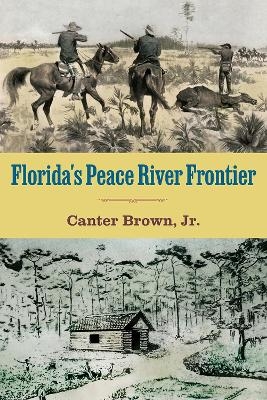
Florida's Peace River Frontier
Seiten
2024
University Press of Florida (Verlag)
978-0-8130-8060-4 (ISBN)
University Press of Florida (Verlag)
978-0-8130-8060-4 (ISBN)
For most of the nineteenth century, southwest Florida and the Peace River Valley remained a frontier as unknown to outsiders as the frontiers of the American West. In this book, Canter Brown, Jr records the area’s economic, social, political, and racial history in an account of violence, passion, struggle, sacrifice, and determination.
The economic, social, political, and racial history of southwest Florida in the nineteenth century
For most of the nineteenth century, southwest Florida and the Peace River Valley remained a frontier as unknown to outsiders as the frontiers of the American West. In this book, Canter Brown, Jr. records the area’s economic, social, political, and racial history in an account of violence, passion, struggle, sacrifice, and determination.
The Peace River originates in Polk County’s Lake Hamilton, one of the many lakes that dot the heart of interior Florida. It flows past the towns of Bartow, Fort Meade, Bowling Green, Arcadia, Fort Ogden, and Punta Gorda, finally meeting the sea at Charlotte Harbor on Florida’s southwest Gulf Coast. No great cities line its banks; no commerce passes along its waters. Still, the river has bent and molded events of lasting significance to Florida and to the nation.
Using such primary materials as government records, manuscript collections, and newspapers published throughout the country, Brown documents the presence of Native Americans and African Americans in the area in the aftermath of the First Seminole War. He examines the Civil War and Reconstruction periods, paying particular attention to the Union/Confederate, Republican/Democratic split among the area’s residents. In the final sections of the book he describes the arrival of the railroad and the growth of towns, the phosphate boom, and consequences of the Great Freeze of 1895.
Throughout this account, the author identifies by name hundreds of persons who participated in these events, believing, he says, that the stories of individuals and families are a vital part of the area’s history. Florida’s Peace River Frontier will appeal to readers interested in Florida history, the Civil War and Reconstruction eras, African American history, and the history of the American frontier.
The economic, social, political, and racial history of southwest Florida in the nineteenth century
For most of the nineteenth century, southwest Florida and the Peace River Valley remained a frontier as unknown to outsiders as the frontiers of the American West. In this book, Canter Brown, Jr. records the area’s economic, social, political, and racial history in an account of violence, passion, struggle, sacrifice, and determination.
The Peace River originates in Polk County’s Lake Hamilton, one of the many lakes that dot the heart of interior Florida. It flows past the towns of Bartow, Fort Meade, Bowling Green, Arcadia, Fort Ogden, and Punta Gorda, finally meeting the sea at Charlotte Harbor on Florida’s southwest Gulf Coast. No great cities line its banks; no commerce passes along its waters. Still, the river has bent and molded events of lasting significance to Florida and to the nation.
Using such primary materials as government records, manuscript collections, and newspapers published throughout the country, Brown documents the presence of Native Americans and African Americans in the area in the aftermath of the First Seminole War. He examines the Civil War and Reconstruction periods, paying particular attention to the Union/Confederate, Republican/Democratic split among the area’s residents. In the final sections of the book he describes the arrival of the railroad and the growth of towns, the phosphate boom, and consequences of the Great Freeze of 1895.
Throughout this account, the author identifies by name hundreds of persons who participated in these events, believing, he says, that the stories of individuals and families are a vital part of the area’s history. Florida’s Peace River Frontier will appeal to readers interested in Florida history, the Civil War and Reconstruction eras, African American history, and the history of the American frontier.
Canter Brown, Jr., retired professor of history and political science at Fort Valley State University, is the author or coauthor of several books, including For a Great and Grand Purpose: The Beginnings of the AMEZ Church in Florida, 1864-1905 and Mary Edwards Bryan: Her Early Life and Works.
| Erscheinungsdatum | 05.12.2023 |
|---|---|
| Verlagsort | Florida |
| Sprache | englisch |
| Maße | 152 x 229 mm |
| Gewicht | 272 g |
| Themenwelt | Geschichte ► Allgemeine Geschichte ► Neuzeit (bis 1918) |
| Geisteswissenschaften ► Geschichte ► Regional- / Ländergeschichte | |
| Geschichte ► Teilgebiete der Geschichte ► Kulturgeschichte | |
| ISBN-10 | 0-8130-8060-6 / 0813080606 |
| ISBN-13 | 978-0-8130-8060-4 / 9780813080604 |
| Zustand | Neuware |
| Haben Sie eine Frage zum Produkt? |
Mehr entdecken
aus dem Bereich
aus dem Bereich
Europa 1848/49 und der Kampf für eine neue Welt
Buch | Hardcover (2023)
DVA (Verlag)
CHF 67,20
Giordano Bruno - ein ketzerisches Leben
Buch | Hardcover (2024)
C.H.Beck (Verlag)
CHF 41,85


